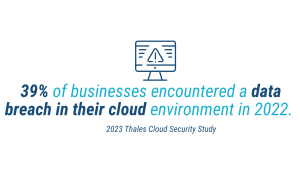Why Should I Reassess My Cloud Security in 2024?
With each passing year, it’s no surprise that the risk of data breaches and unauthorized access intensifies– which is why we remind organizations to reassess their defenses each year.
The alarming reality is that 39% of businesses encountered a data breach in their cloud environment in 2022, marking a concerning 4-point increase from the previous year, while simultaneously, 75% of businesses reveal that over 40% of their stored data in the cloud is sensitive, reflecting a substantial 26% surge from the previous year.
For organizations navigating the cloud, fortifying your cloud security is non-negotiable. If the processes or solutions listed below aren’t already part of your strategy, it’s worth giving them serious consideration. Let’s explore a few powerful security solutions to fortify your cloud security in the new year.

1. Security Orchestration, Automation and Response (SOAR)
Effortlessly streamline your security operations with Security Orchestration, Automation, and Response (SOAR), a term coined by Gartner. This transformative solution integrates security orchestration, automation, incident response, and threat intelligence, simplifying the management of threats, vulnerabilities, and security incidents. SOAR eliminates complexity, allowing your team to concentrate on responding to the most critical threats and easing the burden on IT teams.
This holistic and proactive approach enhances cloud security by automating responses, centralizing orchestration, integrating security tools, facilitating investigation, incorporating threat intelligence, automating workflows, and providing real-time monitoring. These capabilities collectively empower organizations to fortify the resilience and effectiveness of their cloud security measures.
2. Zero Trust Policies
Challenge the norm with a Zero Trust framework, where every request is logged, all traffic is assessed, and access to resources is restricted. A transparent audit trail ensures security. Zero-Trust, according to the Cybersecurity and Infrastructure Security Agency (CISA), is a powerful concept aiming to enhance security by minimizing uncertainty in access decisions. In simpler terms, it suggests not trusting any user by default and verifying each user before granting access to resources. This involves real-time authentication, authorization, and encryption for every user request, both inside and outside the business’s perimeter. By adopting Zero Trust Architecture (ZTA), businesses can significantly reduce the risk of breaches.
3. Cloud Access Security Broker (CASB)
Enforce Zero Trust access control with CASB solutions, gaining visibility into how users and applications interact with cloud-based applications while ensuring compliance.
Cloud Access Security Broker (CASB) acts as a vital intermediary between cloud providers and users, ensuring that an organization’s security policies for cloud application access and usage are enforced. Positioned between users and cloud platforms, a CASB serves as the focal point for managing diverse security policies. It applies these policies comprehensively to safeguard every facet of an organization’s activities in the cloud. As businesses continually integrate cloud applications, securing access becomes paramount to uninterrupted operations. Given the various ways attackers exploit cloud apps to infiltrate networks, monitoring user behavior, safeguarding sensitive data, and overseeing third-party apps are essential measures for organizational protection.

4. AI and ML-Powered Threat Detection and Response
Use solutions powered by AI and ML to detect emerging threats by identifying patterns and anomalies, providing early detection for enhanced security.
AI and ML-powered cybersecurity solutions bring invaluable benefits to organizations safeguarding their cloud environments. These technologies excel in advanced threat detection by rapidly analyzing vast datasets, enabling early identification of emerging threats. Their automation capabilities streamline routine tasks, ensuring consistent and real-time application of security measures. Adaptability to evolving threats, behavioral analysis for anomaly detection, and the reduction of false positives contribute to a more accurate and proactive defense. The scale and speed at which AI and ML operate are crucial for handling the nature of cloud environments, while continuous learning ensures that security measures remain up-to-date against emerging vulnerabilities. In essence, these technologies provide organizations with a proactive, adaptive, and efficient approach to tackle the dynamic challenges of modern cyber threats in the cloud.
5. Extended Detection and Response (XDR)
Unify data visibility and analytics across your entire network, including the cloud, with XDR, providing security analysts with comprehensive insights.
Extended Detection and Response (XDR) emerges as a critical asset in maintaining robust cloud security. XDR goes beyond traditional Endpoint Detection and Response (EDR) systems, offering a holistic and optimized security solution. In the face of an evolving threat landscape and the complexities of multi-cloud and hybrid environments, XDR proves to be an efficient and proactive choice for enterprises.
XDR integrates protection across a broad spectrum of elements, encompassing endpoints, servers, cloud applications, emails, and more. Through a seamless integration of prevention, detection, investigation, and response capabilities, XDR provides enhanced visibility, analytics, correlated incident alerts, and automated responses. This comprehensive approach significantly improves data security, empowering organizations to effectively combat evolving threats in the cloud.

6. Cloud Workload Protection Platform (CWPP)
Discover and protect your workloads with CWPP, offering vulnerability scans, runtime protection, malware detection, and network segmentation for increased security.
Cloud Workload Protection Platform (CWPP) is a robust cybersecurity solution designed to safeguard various elements within an organization’s cloud environments. This encompasses physical servers, serverless functions, virtual machines, and containers. As organizations expand their digital landscapes, the associated increase in environments brings potential security risks. To effectively counteract these risks and swiftly respond to active threats, companies require solutions capable of monitoring and protecting diverse cloud workloads. CWPPs play a crucial role in this scenario by continuously and automatically detecting and addressing threats, vulnerabilities, and errors across the specified infrastructures, ensuring the security of workloads interacting with cloud environments.
Let’s Have a Secure 2024!
As we venture into the new year, embracing these strategies ensures not only the resilience of your cloud environment but also a proactive stance in safeguarding sensitive data and maintaining the trust of stakeholders.




